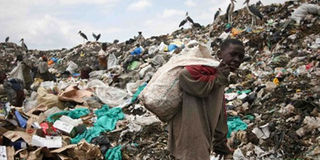Nema raises the red flag over risks of dumping toxic waste

Nairobi’s main dumping site in Dandora. Poor disposal of used needles, syringes and other toxic waste on uncontrolled dumping sites now a major threat to the public health, according to NEMA. Photo/FILE
The country’s environmental watchdog has raised the red flag over the manner in which medical and electronic waste in the country is disposed.
The National Environmental Management Authority in a report says poor disposal of used needles, syringes and other toxic waste on uncontrolled dumping sites have become a major threat to the public health.
Electronic or e-waste are old equipment that have ceased to be of any value to their owners. It includes electronics that are destined for re-use, resale, salvage, recycling or disposal.
With regard to medical waste, the World Health Organisation has already warned that injections given with contaminated syringes cause about 23 million infections of hepatitis B, Hepatitis C and HIV worldwide.
According to its latest report on the state of the country’s environment, Nema says the key driver for indiscriminate dumping of medical waste from hospitals in the country is the lack of proper disposal facilities, particularly incinerators.
Incineration centres, reveals the report, are limited and where available, are either broken down or improperly used.
“It is known that incineration as a waste treatment technique releases toxic gases produced by combustion of the by product or other materials, and this can affect the environment and human health,” reads the report.
Some of the health institutions licensed to operate incinerators, according to the report, include Tenwek Hospital in Bomet, Aga Khan Hospital both in Kisumu and Mombasa, Lions Sight First Eye Hospital and Aga Khan University Hospital all in Nairobi.
Others are Franciscan Sisters of St Joseph’s in Kisii, Muthale Mission Hospital in Kitui and Moi Teaching and Referral Hospital.
In addition to this, other organisations that have been licensed to incinerate an assortment of hazardous waste according to the report include Oserian Development Corporation, Environment and Combustion, Green City Incinerator, Mabati Rolling Mills, Enviro-Safe, East African Portland Cement, Standard Rolling Mills, Agro Chemical and Food Company, James Finlay Kenya Limited, Homegrown Kenya and Envirowaste.
The environmental watchdog says that the low number of licensed incinerators indicates that a large number of Kenyans are exposed to dangers.
“Whereas the opportunity exists for medical facilities to transport waste to commercial incinerators for disposal, there is no evidence to support this practice on the ground,” reads the report.
“It is a common practice for most of the hazardous medical waste to be dumped in shallow pits within the precincts of the medical institutions,” it goes on.
“These pits are easily accessible by scavenging birds and rodents. These then serve as reservoirs for disease transmission. In addition, these pits are not properly lined and there is a real risk of contaminating underground water sources,” adds the report.
Further, the watchdog points out, many jobless people forage in these pits in search of salvageable items for sale.
“These people are exposed to the risk of contact with contaminated material or being pricked by the sharp objects. The attempt to dispose of the waste by periodic burning only exacerbates the problem as it exposes the surrounding communities to dangerous fumes,” says the report.
Nema also says that proper quantification of waste in the country has not been done.
Medical waste
Because of this data gap, they say, it has been difficult to formulate effective strategies to deal with medical waste management.
“Moreover, a number of agricultural and veterinary labs might be disposing of waste that could fall within the biomedical category in an unhygienic manner as none of the latter facilities have been licensed by Nema,” they say.
The environmental body says that the exact amount of e-waste generated in the country is not known.
However, a study conducted by the Unep in 2009 puts the quantity of electronic equipment that consist of personal computers and mobile phones in the Kenyan market at 5,650 metric tonnes.
According to the report, e-waste contains harmful fractions.
“Lead is found in the Cathode Ray Tubes of computers and television monitors. The metal causes damage to the nervous system,” says the report.
It goes on: “Mercury, a hazardous metal used in flat panel display screens is a neurotoxin. High levels of mercury damages the nervous system and the developing foetus. It is also difficult to get rid of mercury once it is released to the environment.”
Furthermore, adds the report, circuit boards and batteries of the electronic equipment contain cadmium which is directly implicated in the promotion of various types of cancer, among other types of disease.
The environmental watchdog wants the country to enforce strict laws to ensure that it does not “unwittingly” become an importer of e-waste.
This is because there have been incidents of electric goods earmarked for transit ending up in the country. There have also been incidents of deliberate mislabelling of containers in a bid to conceal the true identity of goods.
“This has led to substandard electric and electronic goods finding its way into the local market,” says the report.




